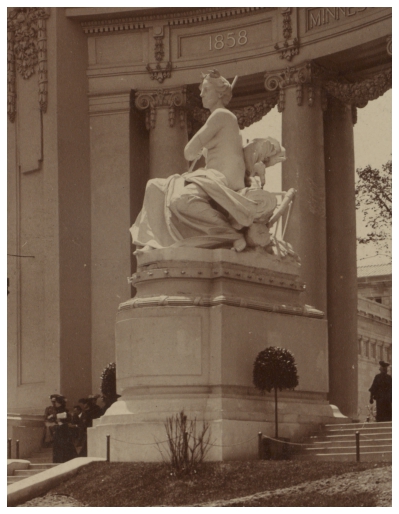Minnesota's building resembled `the Byzantine.' It was designed for a southern climate. The entire lower floor could be thrown open by means of large glass doors opening upon corridors and a wide promenade, which was protected by awnings. It was decorated with staff ornaments inside and out, and had burlap paneled
ceilings.
Inside, the state building included a reception room 30 by 50 feet in size, with reading tables, the files of the State papers, a post-office, check room, and superintendent's office. A men's room and a women's room, each 20 by 20 feet, opened from the reception room. Two pianos were free for the use of guests, and were a much-appreciated feature. Every possible convenience was afforded to visitors.
That the general public, as well as visitors from Minnesota, appreciated the building was shown by the hundreds who visited it daily and the many who
came day after day to write letters, read the papers, or merely to rest
and enjoy its coolness.
The location gave it added prominence, as it was near the southeast entrance, one of the most convenient for visitors, close to the Inside Inn, and with the Massachusetts, New York, Iowa, and Kansas buildings as neighbors.
The furniture was largely furnished by the Mechanical schools of St. Paul and Minneapolis.
Suites for commissioners occupied the second floor.
The 92 by 82 foot edifice contained a 100-seat restaurant.
The structure cost 17,372 dollars.
In the Palace of Agriculture, the state was fortunate in its location, as it was on one of the large central aisles and adjoining the great glass butter refrigerator, where were shown all the competing fancy butter exhibits from the various states. On an eight-faced glass refrigerator; it was 8 x 10 feet by 15 feet high, contained a huge statue in butter of he statue in butter of a mother giving to her little boy, who stood at her side, a piece of bread and butter, up atop a pedestal and state seal. Nearly a ton of the best creamery butter made in this exhibit.
In another refrigerated container, a 8 by 16 feet representation of Father
Hennepin discovering St. Anthonys Falls was also sculpted in butter.
In the Palace of Horticulture, after a new harvest, the state exhibited a Dutch windmill and tower, done entirely in apples.
Minnesota had a credible exhibit of cattle, horses, and swine.
Minnesota had a sizeable exhibits at the Palaces of Mines and Metallurgy Forestry, Fish and Game (tanks of fresh-water fish), and Education as well.




